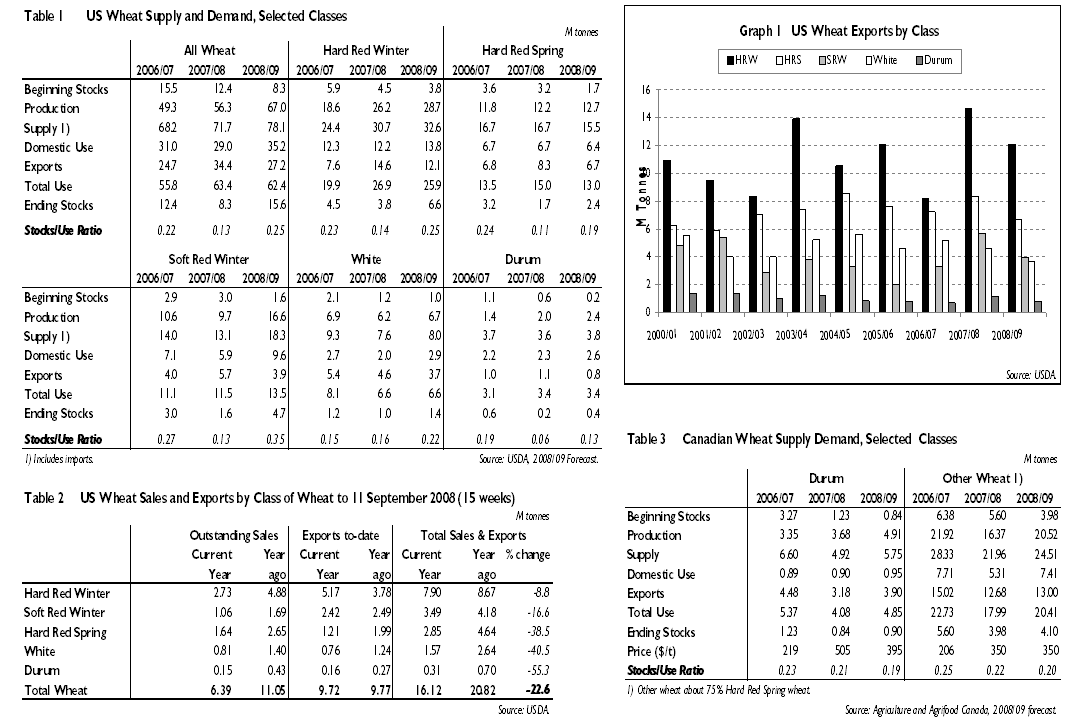
US and Canadian Wheat Prospects
- Monday September 29, 2008
This analysis featured in the September 29, 2008 issue of the HGCA's MI Prospects, Volume 11, Issue 7
Key Points
US export prospects for wheat are less favourable than last year. The outlook for Hard Red Winter and Hard Red Spring wheats have held up better than that for Soft Red Winter wheats which compete more directly with increased supplies from across Europe.
Total US wheat supplies for 2008/09 are estimated at 78.1Mt, up 9% from last year. Production is seen 19% higher, easily offsetting a 33% decline in opening stocks (Table 1). The USDA is currently projecting a 21% rise in domestic consumption to 35.2Mt, a 21% cut in exports to 27.2Mt and an 88% re-build in ending stocks to 15.6Mt. This would result in a stocks-to-use ratio of about 25% compared to a 5-year average of 22%.
Prospects, however, vary by class of wheat (Graph 1). For Hard Red Winter (HRW) wheat, the largest class of US wheat, production and supply were up modestly, by 10 and 6%, respectively. Exports of HRWs are projected 17% lower, as the recovery of Australian and Canadian output will probably limit US exports prospects in this sector. Projected ending stocks of 6.6Mt would result in a stocks-to-use ratio of 25%, above the 5-year average of 21%. The US Wheat Associates reports that the quality of the HRW crop is above average and better last year.
Estimated supplies of US Soft White Winter wheat, which is grown in the Pacific Northwest, are seen to exceed projected disposition, enabling a build-up in ending stocks and in a stocks-to-use ratio close to the 5-year average. Although US durum production is seen higher for a second consecutive year, reduced opening stocks mean supplies will only increase by 4%. The USDA’s projected domestic consumption suggests that the US will be a net-importer of durum wheat this season.
Export and export sales after 15 weeks of the crop year are beginning to reflect the USDA’s full crop year projections. Up to 11 September physical exports at 9.7Mt were close to those last year, but outstanding sales, those made but not shipped have been declining in recent weeks (Table 2). These, at 6.4Mt, are 42% of last year’s outstanding sales at this time. HRW wheat is lagging year ago exports by 9%, those for SRW wheat are 17% behind.
Production of other Canadian wheat is estimated at 20.5Mt, 23% above last year, raising total supplies by 12% to 24.5Mt (Table 3). About 75% of this wheat is HRS wheat for which prospects are relatively favourable. Exports are projected to increase by 3% with domestic consumption expected to increase by 40%. The latter increase is anticipated on the basis of more wheat being downrated to feed grades than last year which was exceptional in terms of quality. Ethanol producers in Western Canada are also expected to switch back to wheat from imported US maize on cost considerations. With the 2008 harvest only now being gathered, it is too early to expect current year export forecasts to be reflected in export movements.
The Canadian Wheat Board pool return outlooks (PRO) also suggest that better quality wheat is expected to hold its value. The August PRO for 1 CWRS 13.5% protein, basis in store at tide water was C$358.00/t, only 3% below last year's values; CW Feed wheat at C$236.00/t is 22% lower.
continue
David Walker (001) 780 434 7615
top of page